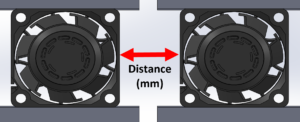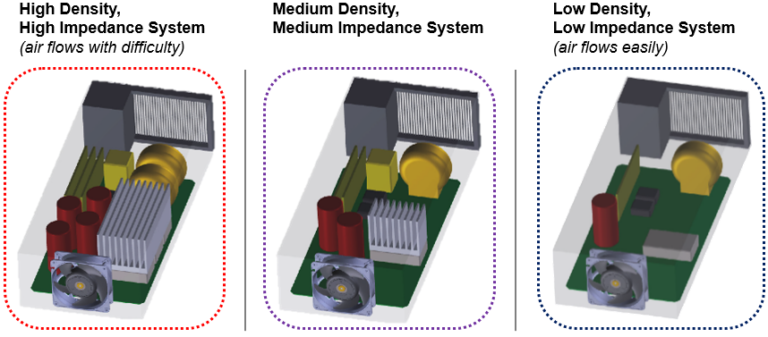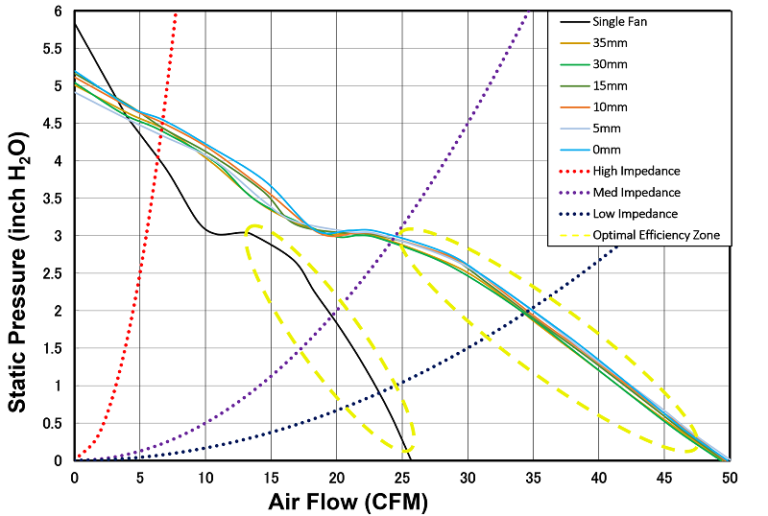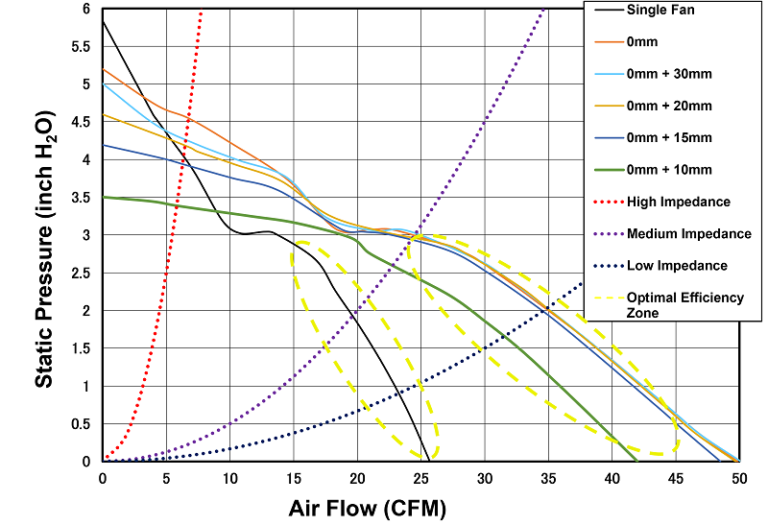Factors to consider when strategically integrating 1U high performance cooling fans for efficient thermal management
The onrush of high-performance processors, such as CPU and GPUs, are ever-increasing in applications such as 1U servers, internet switches, and information and computer technology (ICT) equipment. The amount of data being processed is increasing, larger heat densities are becoming the norm, while the allotted device packaging space is shrinking. As a result, thermal management becomes a crucial aspect of these systems. One method of thermal management is increasing airflow by optimizing the system’s cooling fan.
To satisfy these requirements, Sanyo Denki developed and launched the High Static Pressure Fan San Ace 36 9HV type, 9HV3612P3K001, with PWM control function [1]. Building onto the recent product release, this article will introduce strategies to mitigate heat – putting two fans in parallel and clearing obstructions to the inlet airflow.
Operating Two Fans in Parallel and Spacing
A straight-forward method of increasing airflow through a system is to mount another cooling fan. In theory, putting two fans in parallel would double the total airflow. For parallel fans in compact systems, another consideration is how much space can be left in between the two fans, while avoiding turbulent interference. The setup is showcased in Figure 1. Example systems of various system impedances are shown in Figure 2.


The static pressure (P) and air flow rate (Q) performance [2] is shown in Figure 3 (P-Q curve). The dotted red, purple, and blue lines represent system impedance examples, ranging from high impedance to low impedance [3]. The yellow dotted circle is the operating zone where Sanyo Denki recommends running the fans for highest efficiency.
Due to the 36mm 9HV type fan’s particularly small size, the distance between parallel fans has negligible performance impacts. It is also observed that in the parallel setup, the airflow rate does double, up to 50 CFM when compared to the single fan setup, which has an airflow of 25 CFM. Therefore, placing the 9HV3612P3K001 fans in parallel allows for great design flexibility as the fans can be placed close together to save space, or further apart to target different areas of the system to cool.
Effect of Obstruction on Parallel Fans
Another placement variable that can be detrimental to fan operation is whether the inlet of the fan has obstructions. The distance between a flat sheet of metal and the inlet side of a single or parallel fan setup was studied, and the setup is shown in Figure 4 with results shown in Figure 5.


For the parallel fan setup, there were negligible performance effects from inlet obstructions at 30mm, 20mm, and 15mm. However, once the inlet obstruction got closer at 10mm, there was reduction of the airflow performance for the parallel setup. To maximize airflow performance of a single or parallel fan setup, it is recommended to keep inlet obstacles at least 15mm away from the fan.

Conclusion
Smaller form factors and higher performance fans can contribute to new energy efficient ICT equipment, which has broad-ranging applications that can protect the environment and people’s health and safety. Some examples of the applications include green infrastructure, advancement of healthcare research such as cloud computing for infectious diseases, vaccine development, and biomolecular modeling. Other usage cases could lead to increasing healthcare access and availability of information, improving remote work access, and bolstering virtual learning and education.
This article has overviewed the space limitation and thermal management challenges in a high-performance system, and introduced San Ace 36 9HV type fans, which address these challenges. 9HV3612P3K001 has an innately small form factor at 36 x 36 x 28mm while delivering high static pressure and high airflow performance on par with its 38 x 38mm and 40 x 40mm San Ace counterparts.
Sanyo Denki studied compact fan placement and found that incorporating a parallel fan setup at any spacing and keeping obstructions at least 15mm away from the inlet would optimize the cooling performance of a system, while saving space in that compact system.
There are future studies that Sanyo Denki plans to conduct. Some include investigating the performance of parallel fans in an actual system and studying the distance between inlet obstruction versus sound performance.
Written by Jerry Wu, Greg Tamashiro and Vik Khanikar
